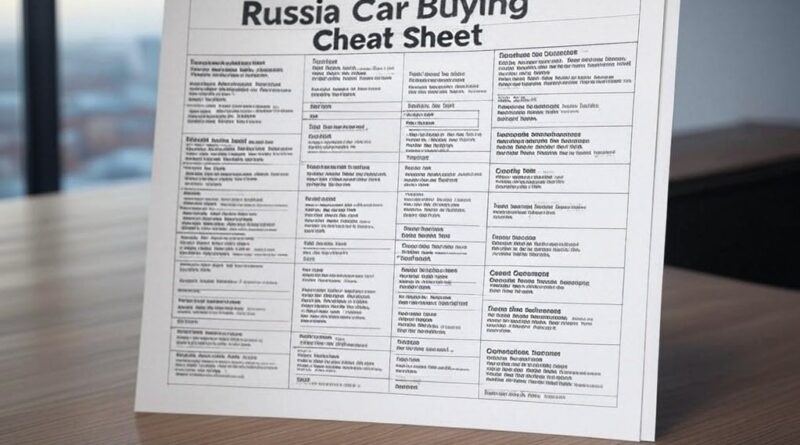Russia Car Buying Cheat Sheet: A No-Nonsense Guide
Thinking about buying a car in Russia? Whether you’re living there or just need a reliable set of wheels, the used car market in Russia can offer great deals — if you know what you’re doing. Here’s a simple, real-world cheat sheet to help you buy smart and avoid nasty surprises.
✅ 1. Imported from Japan (Right-Hand Drive – Eastern Russia)
- Most popular in Siberia, Vladivostok, Khabarovsk, etc.
- These are used Japanese cars bought at auction, often in very good condition.
- Reliable brands like Toyota, Honda, Nissan dominate.
- Shipped to Russian ports, converted if needed, and sold through dealers.
👉 Why? Japanese cars are cheaper, better equipped, and last longer.
✅ 2. Imported from Europe (Germany, Lithuania, Finland, etc.)
- Popular in Western Russia, Moscow, and major cities.
- Often mid-range and premium brands (BMW, Mercedes, Audi, VW).
- Many are ex-lease cars or former fleet vehicles.
- Some may be salvage or crash-damaged, repaired, and sold.
👉 Always check for rebuilt or repainted panels.
✅ 3. Sold Within Russia and in house manufacturing (Private Resale or Dealer Trade-Ins)
- Locally owned cars go through multiple private owners over time.
- Locally manufactured cars – Russia has history of car production too Avtovaz, Aurus Motors, AvtoVAZ (1966–present), GAZ (1932–present), Kamaz (1969–present), Moskvitch/AZLK (1930–present), NAMI (1918–present), UAZ (1941–present)
- Often traded in through dealerships or sold via platforms like Avito, Auto.ru.
- An influx of various Chinese car manufacturers in Russia too
- These cars tend to be high-mileage, but paperwork is usually traceable.
✅ 4. Salvage & Rebuilds (the Risky Ones)
- Some cars end up in Russia after being declared total losses in Europe or the USA.
- Repaired cheaply and sold as “clean” — especially in the budget market.
- These are often the ones listed as urgent sales or “too cheap” deals.
👉 Watch for U.S. imports with flood or crash damage (check Copart, IAA, etc.).
🚩Here is what to know:
✅1. Always Check the Car’s History
Before you even see the car in person, run a VIN check.
You can use:
- ГИБДД (gibdd.ru) – the Russian traffic police site
- Or various car history check services online
These will show:
- Accident records
- Odometer readings
- Theft reports
- How many owners the car has had
💡 A clean-looking car isn’t always clean on paper. Always check before you go.
✅ 2. Watch Out for Fake Mileage and Rebuilt Wrecks
Unfortunately, mileage rollbacks are common in Russia.
Compare:
- What’s on the dashboard
- What shows in service records or inspection logs
- What the VIN report says
Also be wary of cars that have been written off and rebuilt — they’re everywhere, and some are fixed up just enough to sell.
✅ 3. Don’t Skip an Inspection
Looks can be deceiving.
Always have the car checked by a mechanic or inspection service. What to look for:
- Rust (especially in older cars)
- Engine and gearbox condition
- Suspension and brakes
- Paint mismatches (signs of body repair)
- Always check for rebuilt or repainted panels.
It might cost a bit up front, but it could save you a fortune later.
✅ 4. Get the Paperwork Right
Here’s what you need:
- Your passport (and INN number if you’re Russian)
- The car’s PTS (vehicle passport)
- The STS (registration certificate)
- A signed sales contract (Договор купли-продажи)
Then go together to the local GIBDD office to complete the transfer.
It usually takes under an hour and costs around 1,500–2,000 rubles.
✅ 5. Make Sure the Car Isn’t in Trouble
Before handing over cash, check:
- The FSSP.ru site (Federal Bailiffs Service) for any debts or legal issues
- The VIN again on GIBDD to confirm it’s not stolen or seized
🚨 If the car has an active lien or is part of a legal case, you won’t be able to register it, even if you already paid.
✅ 6. Sort Insurance & Inspection
To legally drive it, you’ll need:
- OSAGO insurance (basic third-party cover)
- A valid technical inspection (required if the car is over 4 years old)
Without these, you can’t register the car.
Red Flags to Walk Away From
| What You See | What It Could Mean |
|---|---|
| Fresh paint on one side | Accident repair |
| Very low mileage on an old car | Mileage rollback |
| No PTS or only a duplicate | Car may be stolen or under loan |
| “Urgent sale, today only!” | Rebuild or risky deal |
Final Thoughts
Buying a used car in Russia isn’t hard — but it does take a little homework.
Check the history, do an inspection, and always double-check the paperwork. Don’t let a low price rush you into a bad deal.
Take your time, and you’ll end up with a solid car that you can trust — without any unpleasant surprises later.
Buying a used VW. Buying used vauxhall, BMW, Jaguar, Ford, Volvo, Range rover, Bentley, Aston Martin, Porsche, Ferrari, Lamborghini, Maserati, Hyundai, Tesla, Honda, Pagani

